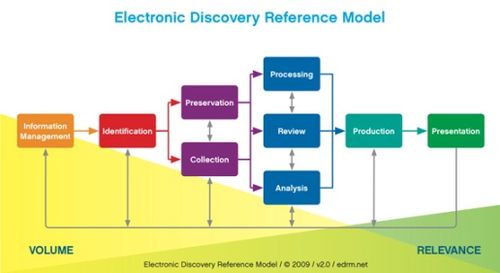eDiscovery Daily Blog
eDiscovery Trends: Reporting from the 2011 EDRM Mid-Year Meeting

The Electronic Discovery Reference Model (EDRM) Project, created to address the lack of standards and guidelines in the electronic discovery market, is now in its seventh year of operation. Most references to the eDiscovery industry these days refer to the EDRM model as the standard representation of the eDiscovery life cycle. I’m happy to say I’ve been a participating member for all but the first year of its existence and that CloudNine Discovery is a participating provider. And, this blog has certainly noted some of the recent efforts and accomplishments within EDRM, including the recently announced information governance collaboration efforts between EDRM and ARMA and the announcement of the first draft of the Model Code of Conduct (MCoC) to focus on the ethical duties of eDiscovery service providers and their clients.
This week, the EDRM Mid-Year meeting has taken place in St. Paul, MN (giving some of us a chance to break out our winter clothes early!). Twice a year, in May and October, eDiscovery professionals who are EDRM members meet to continue the process of working together on various standards projects.
I have joined the new Testing working group, which has been created to provide a methodology for risk evaluation through validation and verification of eDiscovery processes and technologies. We spent time the past two days working to develop a survey of eDiscovery professionals to help us prioritize activities for testing methodology development and the beginning of a checklist for litigation hold notification processes and software.
As data set development is a key component of a good testing program, we also worked to identify additional file types and anomalies to add to the current EDRM Data Set project to aid in that testing. Though the current data set, based on public domain Enron case data, has proven to be an excellent resource for testing eDiscovery software and processes, there are several test examples that could be added to ensure a more complete test set. The Testing working group plans to finalize a first cut at additional data set needs in the next few weeks and will likely take an active role in locating or creating those additional test set examples.
Highlights of activities for other working groups in the Mid-Year meeting include:
- Information Governance Reference Model (IGRM): Working on completing a guide for using the IGRM model as well as use cases and a toolkit for facilitating understanding of the model and how to implement it.
- Evergreen: Has started work on an educational initiative, coordinating with the IGRM working group.
- Model Code of Conduct: Has implemented changes resulting from comments to the working draft of the MCoC document and will be posting the final version of the code soon, they will then be implementing a mechanism to track and recognize the organizations that volunteer to adhere to the code.
- Search: Working on a Sampling and Validation paper and expects to have a working draft ready for comment soon, they also plan to complete a Search Intent Framework and Frequently Asked Questions (FAQ) document by next year’s annual meeting.
- XML: Has revamped the downloads page for downloading the XML schema, with version 1.1 of the schema currently available and a press release to announce version 2.0 of the schema coming soon.
These highlights are based on my notes, so, EDRM members, if I misstated or left out anything, please feel free to comment.
So, what do you think? Has EDRM impacted how you manage eDiscovery? If so, how? Please share any comments you might have or if you’d like to know more about a particular topic.
